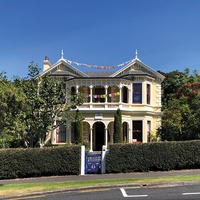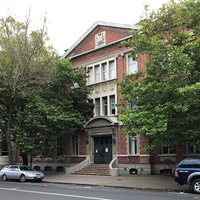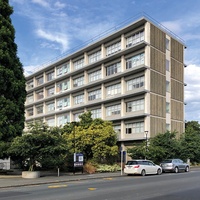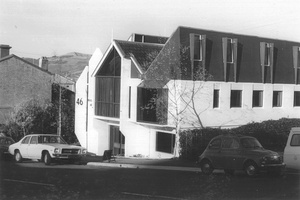Itinerary: Mason & Wales Dunedin
In this month's Itinerary, supported by Dulux Colours of New Zealand, Andrew Barrie and Julia Gatley investigate the legacy of Mason & Wales in Dunedin.

With its origins in the practice formed by William Mason (1810–1897) in Dunedin in 1862, Mason & Wales is New Zealand’s oldest architectural practice. Mason had worked in England and Australia before moving to Auckland in 1840, where his outputs included the building now known as Old Government House (1855–1956), and then on to Dunedin in 1862, where the discovery of gold signalled potential. He set up partnership briefly with David Ross (1827–1908) and then, more significantly, with William Clayton (1823–1877). Tasmanian-born Clayton had designed numerous buildings there before immigrating to Dunedin in 1863, again attracted by the gold rush.
Mason & Clayton’s key buildings included the Colonial Museum in Wellington (1864–1865), Dunedin’s Post Office (1864–1868) and the Otago Provincial Council Buildings (1867). None of these survives.
Mason had been elected to parliament in 1861 and then served as mayor of Dunedin (1865–1867). In semi-retirement, he lived on a North Otago farm from 1867. Meanwhile, Clayton was appointed Colonial Architect in 1869 and moved to Wellington. Mason returned to Dunedin practice in 1871, with Nathaniel YA Wales (1832–1903) as his junior partner. Wales, also English, had immigrated to Dunedin via Melbourne and worked for Mason & Clayton from 1862 as a clerk of works and then as an architect. Mason retired fully in the mid-1870s, and Wales continued the practice.
Like Mason, Wales served as a member of parliament and as mayor of Dunedin (1895–1896). Subsequent partners in the practice have included: Wales’ son, Patrick (Percy) Y Wales (1864–1939; President of the NZIA, 1913–1915); PY’s son, the second NYA Wales (1896–1980; President of the NZIA, 1955–1956); and NYA’s son, the third NYA Wales (1927–2011), who was known as Niel and was made a partner in 1956. Ashley Muir (b. 1946) joined the firm in 1970. The current directors are Francis Whitaker and Hamish Muir, son of Ashley.
Across more than 150 years, the firm’s oeuvre has encapsulated the story of New Zealand architecture, most particularly of Dunedin architecture – from colonial-era pluralism and gold rush exuberance to the gradual embrace of modernism, the adoption of regional inflections, a return to international themes and, now, the response to environmental imperatives.
More than is the case in any other New Zealand city, Dunedin’s architecture is associated with cascading lineages of practice, in which older partners pass the baton to youngsters, or firms amalgamate and split, as in Henry McDowell Smith’s genteel turn-of-the-20th-century practice, which evolved through multiple name changes and today continues as Oakley Gray Architects. Many of the city’s current practices can whakapapa back to the 19th century and these lineages often involve multiple generations of the same families, be they Wales, Wixon, McCoy, Muir or Oakley. It is much easier to track the lineage of those that retain an established name, compared with those that end up with a string of names reflecting the roll-call of partners or directors over time.
This raises the fascinating question of not just how firms evolve but how ideas do. Mason & Wales is a long-running firm but standards have remained high; the map of notable Otago architecture published with this issue includes Mason & Wales projects from 11 decades. Significantly, the firm is still a relatively small one and, throughout its history, the work of each era has been associated with specific personalities. In other cities, we are seeing increasingly large, long-running firms, particularly those focused on commercial work. A quandary faces each one as its size increases and it drifts further – in time and in approach – from the personalities of the original partners or directors. In the life of such a firm, can a distinctive design stance be maintained as the line-up of key players continues to evolve? Can such practices generate a way of distinguishing themselves from one another? And which ones will contribute to our architectural history as significantly as Mason & Wales has done?
THE ITINERARY
01. 1865 – All Saints’ Church (Anglican)

786 Cumberland Street
Mason & Clayton’s All Saints’ is Dunedin’s oldest extant Anglican church. It is attributed to Clayton, as is the transept and chancel addition of 1873, which Mason executed. The building is Early English Gothic Revival, built in brick with polychromatic detailing, including cream bricks and black and white tiles. It is a Category 1 historic place. Lisburn House, 15 Lisburn Avenue, Caversham (1865), has similar architectural expression, while St Matthew’s Anglican Church, 28 Hope Street (1874), followed Clayton’s departure and is more typically High Victorian Gothic Revival. Both are Category 1 historic places.
02. 1871–1872 – Bishopscourt (former)

399 Highgate, Roslyn
Mason & Wales (M&W) produced multiple Presbyterian churches in this period, including those in Herbert (1866), Hampden (1870) and Mosgiel (1870), but Bishopscourt was another Anglican commission, a house for Bishop Samuel Tarratt Nevill and his wife. The bluestone exterior with limestone dressings originally included an octagonal turret, tall chimneys and some 22 rooms. In 1913, the Presbyterian Church bought the building and converted it into a school (Columba College), necessitating additions and alterations which were also designed by M&W. It is a Category 1 historic place.
03. 1878–1879 – Linden

22 Royal Terrace
Mason retired in 1874, and Linden is attributed to Nathaniel Wales. It was built for businessman Jacob Isaacs on the occasion of his marriage to Helene Michaelis. Both were from Melbourne and connected to the Hallenstein clothing dynasty. The Dunedin residence was named after the Michaelis’ Melbourne family home (now an art gallery) and makes reference to it in its central entry, flanking bay windows and projecting verandahs supported on slim columns. The Dunedin building was built of plastered triple brick. It is now the Dhargyey Buddhist Centre and a Category 1 historic place.
04. 1878–1879 – Garrison Hall

8 Dowling Street
The Garrison Hall was built for volunteer militias to meet and practise drills for responding to insurgence and performing at civic events. Such battalions and rifle associations were common in 19th-century New Zealand towns. In Dunedin, architect Nathaniel Wales was captain of the militia. The building is said to be in the Scottish Baronial tradition, with heavy stone walls and limestone dressings, including quoins. The adjoining single-storey Orderly Building was added at 7–9 Burlington Street in 1897 to provide extra drill space. The two buildings together are a Category 1 historic place.
05. 1886 – NZ Insurance Co Building (former)

49–51 Queens Gardens
NZI, designed by Nathaniel Wales, was built in Dunedin’s boom time. It is a three-storeyed palazzo, surpassing the period’s more typical two storeys, with a rusticated ground floor, pilasters, pediments at parapet level and a rounded corner to the intersection of Queens Gardens and Crawford Street. Nearby, at 31–33 Thomas Burns Street, is M&W’s Otago Wool Stores building (1872), taken over by stock and station agents the New Zealand Loan and Mercantile Agency Co in 1874 and extended in 1885, 1915 and 1929. Both buildings are individually listed and are included in the Harbourside Historic Area.
06. 1917 – Scott Building, University of Otago

260–266 Great King Street
The Scott Building was built as part of Lindo Ferguson’s vision for the Otago Medical School. The decision to locate it near the hospital rather than within Otago’s main campus was controversial at the time. Unlike most of the university’s old buildings, it is classical – the preferred academic language of the day. It is a three-storey brick building with Ōamaru stone dressings and steel-framed windows. It housed lecture theatres, specialist departments, a library and specimen museum, and staff and student facilities. It is still used by the Medical School and is listed as Category 2.
07. 1946 – Otago Therapeutic Pool

140–154 Hanover Street
This building demonstrates various modernising tendencies of the 1940s. The concrete and brick exterior retains only remnants of art deco detailing while, internally, reinforced concrete portal frames allow for an uninterrupted span across the main swimming pool area. It was the first large (25x10 yards) pool in New Zealand to be built for therapeutic purposes and has been used by the School of Physiotherapy at Otago for training purposes and by people undertaking physical activity for medical rehabilitation, such as cardiac rehabilitation. It is a Category 2 historic place.
08. 1963 – Wellcome Medical Research Institute,
University of Otago

22 Frederick Street
Built to house the University of Otago Medical School’s research functions, the project was international in both conception and delivery. Funded by the Wellcome Trust in England, this long, sleek slab is the complete package of international modernism: strip windows, brise-soleil shades, off-form and pebble-dashed concrete and a glassy penthouse, all set in lush planting. Those trees have now grown up to mask the main façade but the exterior is, otherwise, still in fairly original condition. Refer NZIA Journal Sept 1963.
Fans of crisp modernism should pop across the road to the Category 1-listed and now recently renovated Dental School (Ministry of Works, 1961).
09. 1969 – Arts Building (Burns Building),
University of Otago

95 Albany Street
This project, like most university buildings of the era, provided a tower for academics but left the student and teaching spaces down at ground level – unfortunate symbolism – but, as became the pattern on the Otago campus, the lecture theatres are expressed as dramatic sculptural volumes. The tower now looks more subdued than it did when first built. The slender pre-cast balustrades – which made explicit the design’s debt to Kenzo Tange’s influential Japanese town halls of the 1950s – have been removed and, as with much Dunedin brutalism, the tower’s raw concrete structure has been painted.
10. 1973 – Mason & Wales Offices

46 York Place
Combining block walls, cantilevered concrete and chisel point roofs, all enlivened internally by a dynamic timber structure, this project will be compared by many viewers to Warren and Mahoney’s (WAM) Christchurch office of a decade earlier. Perhaps capturing something of their respective moments in history, where WAM’s 1960s’ composition is vertiginous and expansive, M&W’s oil-shock era 1970s’ project is horizontal and restrained. The building received an NZIA Local Award in 1973 and is still occupied by the M&W design office, as well as its astonishing archive, covering the firm’s entire history. A cabinet still contains the water-coloured drawings of the 150-year-old ‘Job File 1’. Refer NZIA Journal March 1974.
11. 1982 – Otago Harbour Board Administration Building

12 Wharf Street
This project artfully marries the geometric, glassy vocabulary that was universal in the 1980s with highly contextual nautical imagery. Standing over the water on piles, the building has a prowed form and elevated deck, topped with funnel-like forms hiding rooftop services. M&W completed another mirror-glass office for the Harbour Board at 15 Beach Street, Port Chalmers, in 1980. In a remarkable run, both buildings for the Harbour Board won NZIA National Awards just two years apart. However, in an act of both cultural vandalism and environmental villainy, the Harbour Board has slated the well-maintained Port Chalmers building for demolition and replacement with a new building just metres away.
12. 1986 – DSIR Building

764 Cumberland Street
In contrast to the upright Oxbridge atmosphere of the older parts of the university campus, tall redwoods and domestically scaled buildings give this area a leafy, Berkeley vibe. The roof is pulled down low over pre-cast concrete walls, creating a sense of groundedness. Following a line of development explored by many local firms, the heavy roof is enlivened by square dormers, and an offset along the building’s length allows half of it to disappear behind trees, further embedding it into the landscaping. It is now occupied by Landcare Research and GNS Science, some of the current offshoots of the old Department of Scientific and Industrial Research.
13. 2003 – Centre for Innovation, University of Otago

87 St David Street
Housing laboratories and research spaces, this project is intended to foster collaboration between university staff and external organisations. In another moment of making the global zeitgeist manifest on the streets of Dunedin, this project explores the sophisticated, neo-modernism of MOMA’s Light Construction show of the late 1990s. Externally, shard forms are clad in a uniform glass skin that makes a play of translucency, transparency and reflectivity while, internally, a triple-height foyer passes through the building creating an open connection between its various facilities. Refer Architecture NZ March/April 2008.
14. 2018 – Te Pā Tauira Student Village, Otago Polytechnic

190 Union Street East
This student accommodation stands on the edge of the university-polytech precinct, looking out over the green expanse of Logan Park. The repeating, closely spaced walls required for student rooms made the building an ideal candidate for the use of CLT as the primary structure, and the project expanded the envelope in New Zealand for the use of mass timber – it was, at the time, the largest CLT building in the country. It won a Timber Design Award in 2018 and an NZIA Local Award in 2019, where the jury praised the façade, designed with artist Simon Kaan, “a colourful ‘cloak of leaves’ that is always shifting”.
Other addresses
CML Building (1976) – 125 High Street
Clubs & Societies Centre, University of Otago (1980) – 84 Albany Street
Executive Residence, University of Otago (1994) – 68 Forth Street
Marsh Study Centre, University of Otago (2012) – 697 Castle Street
SOURCES
The Heritage New Zealand Pouhere Taonga website is an excellent source of information on the older Mason & Wales buildings that are listed as historic places. The main sources from which the List entries draw provide additional information. In particular, John Stacpoole’s monograph, William Mason: The First New Zealand Architect (AUP and OUP, 1971) and his broader follow-up text, Colonial Architecture in New Zealand (Reed, 1976) are valuable sources. Stacpoole later wrote the shorter biography of Mason that is published in the Dictionary of New Zealand Biography, now available in Te Ara, the Online Encyclopedia of New Zealand. William Clayton also has a dedicated entry in the Dictionary of New Zealand Biography, written by Anna Crighton. Complementing these sources are Hardwicke Knight and Niel Wales’ Buildings of Dunedin (John McIndoe, 1988) and the New Zealand Historic Places Trust’s Historic Buildings of Otago and Southland of 1989. The University of Auckland Libraries and Learning Services hold Sheppard Collection files on William Mason, William Clayton and various members of the Wales family. These are available through Special Collections in the General Library Building.

The itinerary series is supported by Dulux Colours of New Zealand. Dulux Colour Specialist Davina Harper has selected a Colours of New Zealand palette based on this itinerary. See the full range and order colour samples here.









